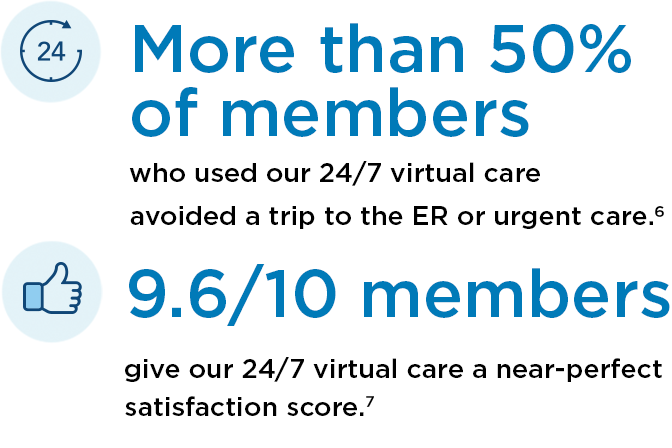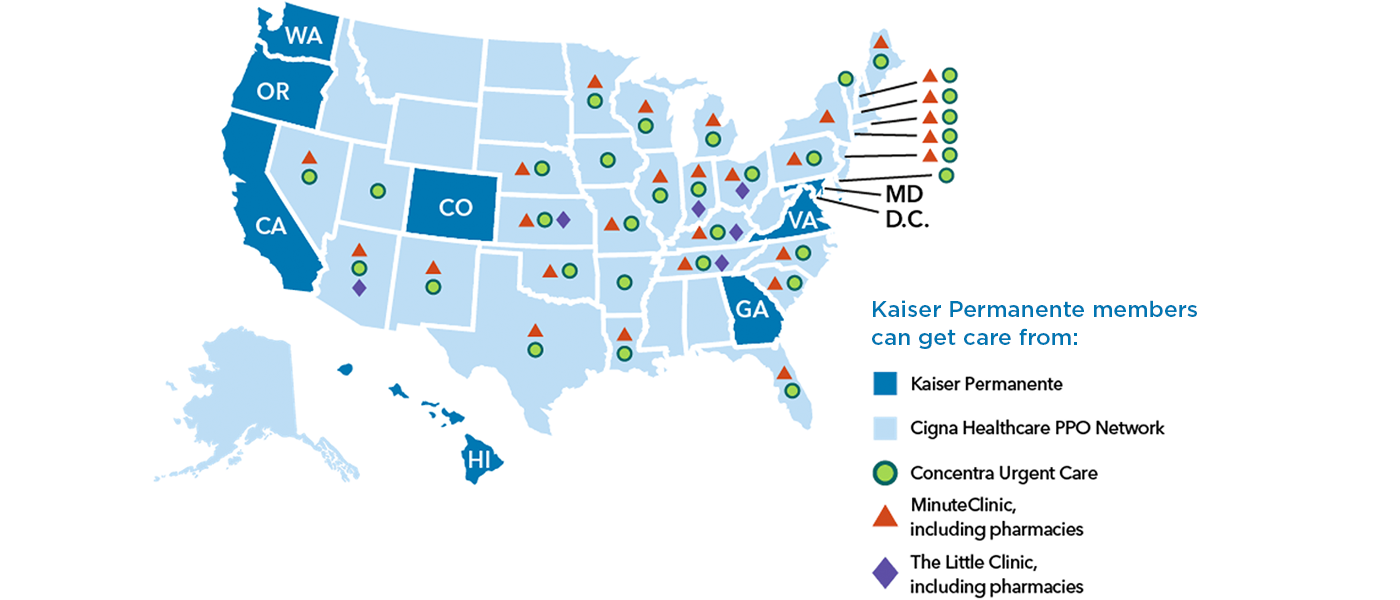Access to care, when and where employees need it
Access to health care is an industry-wide problem. Growing demand for care — especially primary care — amid a shortage of clinicians has led to long wait times and frustrating experiences across the nation.
At Kaiser Permanente, we’re committed to ensuring our members receive the care they need in a timely manner. Our collaborative teams give your employees personalized, high-quality care that meets them where they are — across many locations and specialties.

Addressing the demand for care
We’re actively working to address the growing demand for care. Our efforts to improve access are continuously evolving to meet members’ changing needs — and help them achieve the healthiest possible outcomes.
Our integrated care model catches problems early and improves outcomes
Members don’t need to worry about finding a Kaiser Permanente doctor who accepts their health plan, or being referred to a Kaiser Permanente specialist who isn’t covered. We have more than 24,000 highly skilled physicians all collaborating within one system to get our members the care they need — and they accept all Kaiser Permanente health plans.
When your employees become members, they get integrated in-person and virtual care from a range of primary and specialty care teams that work together to catch problems early, before they become more serious and costly. And if a member faces a potentially serious health issue, knowing that a care team is already in place, ready to guide them through every step, can give them peace of mind when they need it most.
As a result of our coordinated approach, Kaiser Permanente members get care that’s measurably better. In 2024, we were among the top 5% to 10% for many types of care:1
Top 5%
- Kidney health and eye exams for members with diabetes
- Appropriate treatment for upper respiratory infections
- HPV vaccinations in adolescents
Top 10%
- Breast and cervical cancer screenings
- Monitoring and controlling high blood pressure
- Timeliness of prenatal care and vaccines

Find the right plan for your business. Call 877-305-7933
Integrated in-person and virtual care enhance access and member experience
Truly integrated in-person and virtual care offer your employees many convenient ways to get care. At Kaiser Permanente, in-person and virtual care teams are connected to your employees, and to each other, through our electronic health record system.
Our members also need fewer follow-ups after virtual primary care appointments — so your employees spend less time away from work. Outside Kaiser Permanente, telehealth users are almost twice as likely to need follow-up care after a virtual primary care appointment.3
Your employees have access to a wide range of in-person and digital care.
In-person care
Phone & video visits
Secure email
In-person & online physical therapy
Inpatient telehealth services
Prescription delivery
24/7 virtual care & advice
Remote patient monitoring
Online chat
kp.org & mobile app
Online self-service tools
Digital wellness tools
Additional care options in all 50 states
Your employees need access to in-person and virtual care outside normal business hours and away from where they live and work. So, we’ve expanded access accordingly.
24/7 virtual care across the U.S.
Employees can connect with a Kaiser Permanente clinician by phone or video, day or night — no appointment needed. More than 50% of members who used our 24/7 virtual care avoided a trip to the ER or urgent care.4 Members are also highly satisfied with this new service, giving our 24/7 virtual care option a near perfect score of 9.6/10.5

Increased access to in-person care away from home
We’ve also worked hard to make care more accessible and improve the payment experience for members with HMO and EPO plans — who are the vast majority of our members. Outside Kaiser Permanente states, your employees can visit a Cigna Healthcaresm PPO Network provider for urgent or emergency care without paying on-site.8
They can also visit the following urgent care clinics and pay their normal copay or coinsurance:
MinuteClinic, including pharmacies, in Arizona, Connecticut, Florida, Illinois, Indiana, Kansas, Kentucky, Louisiana, Maine, Massachusetts, Michigan, Minnesota, Missouri, Nebraska, Nevada, New Hampshire, New Jersey, New Mexico, New York, North Carolina, Ohio, Oklahoma, Pennsylvania, Rhode Island, South Carolina, Tennessee, Texas, and Wisconsin.
Concentra urgent care in Arizona,Arkansas, Connecticut, Delaware, Florida, Illinois, Indiana, Iowa, Kansas, Kentucky, Louisiana, Maine, Massachusetts, Michigan, Minnesota, Missouri, Nebraska, Nevada, New Hampshire, New Jersey, New Mexico, North Carolina, Ohio, Oklahoma, Pennsylvania, Rhode Island, South Carolina, Tennessee, Texas, Utah, Vermont, and Wisconsin.
The Little Clinic, including pharmacies, in Arizona, Indiana, Kansas, Kentucky, Ohio, and Tennessee.



Find the right plan for your business. Call 877-305-7933
Footnotes:
1Kaiser Permanente 2024 HEDIS® scores. Benchmarks provided by the National Committee for Quality Assurance (NCQA) Quality Compass® and represent all lines of business. Kaiser Permanente combined region scores were provided by the Kaiser Permanente Department of Care and Service Quality. The source for data contained in this publication is Quality Compass 2024 and is used with the permission of NCQA. Quality Compass 2024 includes certain CAHPS data. Any data display, analysis, interpretation, or conclusion based on these data is solely that of the authors, and NCQA specifically disclaims responsibility for any such display, analysis, interpretation, or conclusion. Quality Compass® and HEDIS® are registered trademarks of NCQA. CAHPS® is a registered trademark of the Agency for Healthcare Research and Quality. Continue at [1]
2See note 1. Continue at [2]
3Reed et al., JAMA Network Open, November 16, 2021; Li et al., Health Affairs, April 2021. Continue at [3]
4Kaiser Permanente GCN Post-Visit Survey of 60,945 members, 2023. Continue at [4]
5Kaiser Permanente internal data, December 19, 2023. Continue at [5]
6See note 4. Continue at [6]
7See note 5. Continue at [7]
8The Cigna Healthcare PPO Network refers to the health care providers (doctors, hospitals, specialists) contracted as part of the Cigna Healthcare PPO Network for Shared Administration. Cigna Healthcare is an independent company and not affiliated with Kaiser Foundation Health Plan, Inc., and its subsidiary health plans. Access to the Cigna Healthcare PPO Network is available through Cigna Healthcare’s contractual relationship with the Kaiser Permanente health plans. The Cigna Healthcare PPO Network is provided exclusively by or through operating subsidiaries of The Cigna Group, including Cigna Health and Life Insurance Company. The Cigna Healthcare name, logo, and other marks are owned by Cigna Intellectual Property, Inc. Continue at [8]